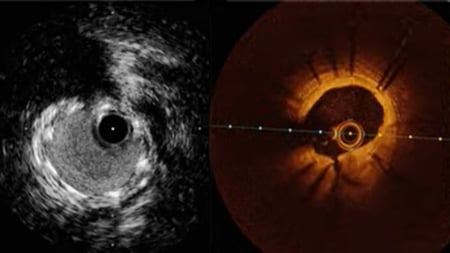Percutaneous treatment and outcomes of small coronary vessels: A SCAAR report
Selected in JACC: Cardiovascular Interventions by N. Ryan , D. Milasinovic
Using the SCAAR database, this observational, nationwide, multicentre cohort study compared outcomes of all consecutive patients undergoing PCI for de-novo stenosis in small coronary vessels (device diameter ≤2.5mm) treated with drug-coated balloons or newer generation drug-eluting stents.
References
Authors
Silverio A, Buccheri S, Venetsanos D, Alfredsson J, Lagerqvist B, Persson J, Witt N, James S, Sarno G
Reference
JACC Cardiovasc Interv. 2020 Feb 5 [Epub ahead of print]
Published
February 2020
Link
Read the abstractReviewers
Our Comment
This joint review is part of the PCRonline GLOBAL Journal Club Initiative by selected members of the EAPCI/PCR Journal Club and PCR NextGen, and is based on the underlying idea of “Bringing peers together, exchanging ideas, towards a common standard of care”.
Using the SCAAR database, this observational, nationwide, multicentre cohort study compared outcomes of all consecutive patients undergoing PCI for de-novo stenosis in small coronary vessels (device diameter ≤2.5mm) treated with drug-coated balloons (DCB) or newer generation drug-eluting stents (n-DES).
Why this study – the rationale/objective?
Small coronary vessels are a challenging subset for PCI with increased risk of restenosis, n-DES have reduced the risk of restenosis, however their use in smaller vessels remains a topic of debate. In certain subgroups of patients, the use of a DCB where an antiproliferative drug is delivered without leaving behind struts or polymers is a potentially attractive therapy. To date trials comparing DCB and DES have given heterogeneous results, with early trials using older generation DES not in common use in current clinical practice. This study examines real-world use of contemporary DCB and n-DES in small coronary vessels.
How was it executed – the methodology?
All consecutive patients undergoing elective, urgent or emergent PCI for de-novo stenosis in small coronary arteries treated with DCB or n-DES from April 2009-July 2017 were included. As coronary vessel sizes are not recorded in SCAAR, a small coronary vessel was defined as a device diameter ≤ 2.5mm. Exclusion criteria included bail-out DES after DCB and patients treated with both DCB and DES in different segments in the same procedure.
- The primary endpoints were clinically relevant restenosis and definite target lesion thrombosis (TLT) at three-year follow-up.
- All cause death and MI at three-year follow-up were secondary endpoints.
- Propensity scoring weighting was used to adjust for potential selection bias between the two treatment groups
What is the main result?
Overall 14,788 patients (1,154 DCB, 13,634 n-DES) underwent 35,541 PCI’s (2,503 DCB, 33,038 n-DES). The median follow-up was 1095 days (IQR 729-1095).
- Patients treated with DCB’s had higher rates of diabetes, hypertension and dyslipidaemia, as well as an increased prevalence of prior PCI, CABG and stable coronary artery disease. In contrast, in the DES group, STEMI, multivessel disease, CTO and complex lesions B2/C were more prevalent.
- At 3 years, 707 clinically relevant restenosis had occurred, 4.1% (102) in the DCB group versus 1.8% (605) in the n-DES group.
- Using propensity score weighted adjusted regression analysis there was a significantly higher risk of restenosis in the DCB group (adj HR 2.027, 95%CI 1.537-2.674, p<0.001), with no significant difference in TLT risk (adj HR 0.741, 95%CI 0.412-1.331, p=0.315).
- In the DCB group, the majority of TLT occurred within six months of PCI (15/16, 93.8%).
- The adjusted risk of all-cause death (adj HR 1.178 95% CI 0.992-1.399, p=0.061) and MI (adj HR 1.251, 95%CI 0.960-1.629, p=0.098) was similar between groups.
- Sensitivity analysis including patients treated with both DCB and DES in different coronary segments, during the same PCI procedure, confirmed the increased risk for restenosis with DCB (adj HR 1.823 95%CI 1.387-2.397, p<0.001).
Critical reading and the relevance for clinical practice
The results of this real-world registry-based study show that after adjusting for baseline clinical and procedural characteristics PCI using a DCB was associated with double the risk of clinically relevant stenosis at three-year follow-up compared to n-DES. There were no significant differences in the risk of target lesion thrombosis, all-cause death or MI.
The ability to capture the entire Swedish population gives a unique insight into the real-world use of DCB’s which may explain some of the differences with RCT’s in this area. In this report, DCB were commonly used in bifurcation lesions despite a lack of robust clinical data supporting this practice. Furthermore, the follow-up duration was longer than any RCT, with clinically-driven follow-up rather than systematic angiographic analysis of lumen loss or %DS. Death and MI rates were similar to those found in RCT’s.
A note of caution when interpreting the results, one must bear in mind that there are some limitations to the data, i.e. information with regard to predilatation, which can impact DCB success, and DAPT duration are not available, although restenosis is less influenced by DAPT duration. Furthermore, device size was used as a surrogate for vessel size, over or under-sizing the device may influence outcomes particularly in small vessels. Finally, there may have been few or no symptoms associated with significant restenosis due to the limited area of myocardium supplied by small vessels, therefore some cases of restenosis may not have been detected.
Given the divergent outcomes between this report and the RCT’s to date, the use of DCB’s in everyday clinical practice needs to be carefully considered and individualised to the patient. Future randomized trials adequately powered to detect differences in clinically significant endpoints, as well as standardisation of definitions will help guide therapy in small coronary vessels.







No comments yet!